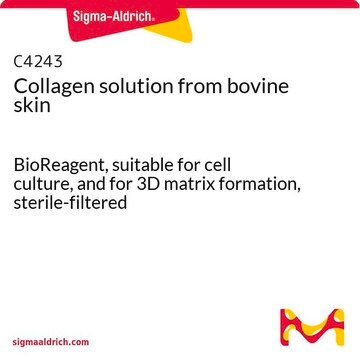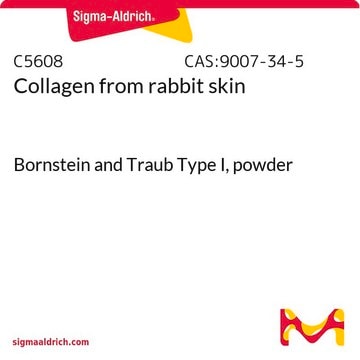5162
Bovine Collagen Type I
from bovine flexor tendon, powder, suitable for cell culture, used for 3D gel formation
Synonym(s):
Collagen Protein, Collagen Solution, Collagen Type I
About This Item
Recommended Products
product name
Collagen, from bovine flexor tendon
biological source
bovine flexor tendon
sterility
non-sterile
Assay
>96%
form
lyophilized powder (fibrous)
packaging
pkg of 1 g
technique(s)
cell culture | mammalian: suitable
UniProt accession no.
Binding Specificity
Peptide Source: Elastin
Peptide Source: Fibronectin
Peptide Source: Laminin
shipped in
wet ice
storage temp.
room temp
Gene Information
bovine ... COL2A1(407142)
Related Categories
General description
This collagen product is naturally cross-linked yielding a robust material for applications which require structure and strength. This product can be readily prepared into such forms as tissue scaffolds, foams, sponges, suspensions, coatings, putties, films and sheets but does not form hydrogels. Using typical cross-linking methods, this material can be tuned for optimal in vivo resorption. This collagen product is ideal for tissue engineering applications and uses with inorganic and biomaterials.
The product is provided in user-friendly packaging for use and storage. Avoid extended exposure to ambient environment since this material is hygroscopic.
Preparation Note
Note: The following procedure is based on solubilization of 1 gram of collagen in 100 ml to initially prepare a 10 mg/ml collagen suspension. Smaller quantities and volumes may be used but the same ratios of collagen and solutions should be used.
1. Weigh out 1 gram of collagen fibrous powder.
2. Reconstitute 1 gram of collagen with 50 ml of cold purified water (50% of the final volume).
3. Stir the collagen with the water continuously mixing for a minimum of 15 minutes until the collagen is fully wetted and the suspension appears to be a semi-solution.
4. Add 50 ml of cold 0.02 M HCl to the collagen mixture and stir for a minimum of 10 minutes. This will yield a collagen concentration of 10 mg/ml with the suspension continuing to appear as a semi-solution.
5. Measure the pH - the mixture should have a pH of 2 to 3.
6. Using Waring stick blender or equivalent, homogenize the collagen mixture for a minimum of 15 minute at a high speed ensuring that the collagen is fully homogenized. Ensure that the temperature of mixture does exceed 24°C. Upon completion, there should be no visual solids in the viscous suspension. Air bubbles with be prevalent.
7. To remove air bubbles, stir the solution on a stir plate and pull a vacuum on the suspension. This will remove the air bubbles.
8. At this point if a collagen concentration of less than 10 mg/ml is desired, the collagen can be diluted with 0.01 M HCl.
Other Notes
Applications
General Filtration of 15 to 50 mL Samples, Preparation for Scintillation Counting
XX2702550 1225 Sampling Manifold
Replacement Parts
YY2214257 Hand Knob
5162 Top Plate
XX2702509 Filter O-ring, silicone
5163 Support Plate
XX2702510 Support Screen, 25 mm, polypropylene
XX11000PP Ball Valve, glass-filled polypropylene
XX2504755 Tubing, 1/4 in. x 23 in., latex
Accessories
XX2702552 Chamber O-rings and Plug Set
XX2702555 Sample Cup Extension Barrel
XX6200006P Filter Forceps, blunt end, stainless steel
XX7100004 Tubing 3/16 in. I.D. x 140 cm, silicone
Storage Class Code
11 - Combustible Solids
WGK
WGK 1
Flash Point(F)
Not applicable
Flash Point(C)
Not applicable
Certificates of Analysis (COA)
Search for Certificates of Analysis (COA) by entering the products Lot/Batch Number. Lot and Batch Numbers can be found on a product’s label following the words ‘Lot’ or ‘Batch’.
Already Own This Product?
Find documentation for the products that you have recently purchased in the Document Library.
Customers Also Viewed
Our team of scientists has experience in all areas of research including Life Science, Material Science, Chemical Synthesis, Chromatography, Analytical and many others.
Contact Technical Service









